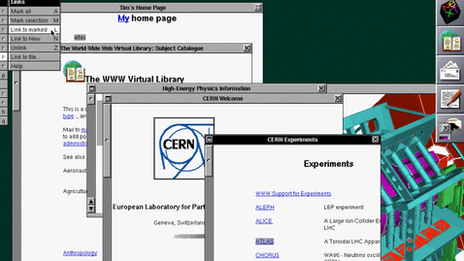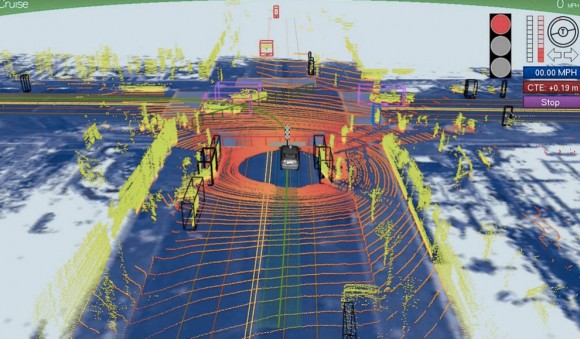Via BBC
-----

Lost to the world: The first website. At the time, few imagined how ubiquitous the technology would become
A team at the European Organisation for Nuclear Research (Cern) has launched a project to re-create the first web page.
The aim is to preserve the original hardware and software associated with the birth of the web.
The world wide web was developed by Prof Sir Tim Berners-Lee while working at Cern.
The initiative coincides with the 20th anniversary of the research centre giving the web to the world.
According to Dan Noyes, the web
manager for Cern's communication group, re-creation of the world's first
website will enable future generations to explore, examine and think
about how the web is changing modern life.
"I want my children to be able to understand the significance
of this point in time: the web is already so ubiquitous - so, well,
normal - that one risks failing to see how fundamentally it has
changed," he told BBC News
"We are in a unique moment where we can still switch on the
first web server and experience it. We want to document and preserve
that".
The hope is that the restoration of the first web page and web site will serve as a reminder and inspiration of the web's fundamental values.
At the heart of the original web is technology to
decentralise control and make access to information freely available to
all. It is this architecture that seems to imbue those that work with
the web with a culture of free expression, a belief in universal access
and a tendency toward decentralising information.
Subversive
It is the early technology's innate ability to subvert that makes re-creation of the first website especially interesting.
While I was at Cern it was clear in speaking to those
involved with the project that it means much more than refurbishing old
computers and installing them with early software: it is about
enshrining a powerful idea that they believe is gradually changing the
world.
I went to Sir Tim's old office where he worked at Cern's IT
department trying to find new ways to handle the vast amount of data the
particle accelerators were producing.
I was not allowed in because apparently the present incumbent is fed up with people wanting to go into the office.
But waiting outside was someone who worked at Cern as a young
researcher at the same time as Sir Tim. James Gillies has since risen
to be Cern's head of communications. He is occasionally referred to as
the organisation's half-spin doctor, a reference to one of the
properties of some sub-atomic particles.
Amazing dream
Mr Gillies is among those involved in the project. I asked him why he wanted to restore the first website.
"One of my dreams is to enable people to see what that early web experience was like," was the reply.
"You might have thought that the first browser would be very
primitive but it was not. It had graphical capabilities. You could edit
into it straightaway. It was an amazing thing. It was a very
sophisticated thing."
Those not heavily into web technology may be
sceptical of the idea that using a 20-year-old machine and software to
view text on a web page might be a thrilling experience.
But Mr Gillies and Mr Noyes believe that the first web page
and web site is worth resurrecting because embedded within the original
systems developed by Sir Tim are the principles of universality and
universal access that many enthusiasts at the time hoped would
eventually make the world a fairer and more equal place.
The first browser, for example, allowed users to edit and
write directly into the content they were viewing, a feature not
available on present-day browsers.
Ideals eroded
And early on in the world wide web's development, Nicola
Pellow, who worked with Sir Tim at Cern on the www project, produced a
simple browser to view content that did not require an expensive
powerful computer and so made the technology available to anyone with a
simple computer.
According to Mr Noyes, many of the values that went into that
original vision have now been eroded. His aim, he says, is to "go back
in time and somehow preserve that experience".

Soon to be refurbished: The NeXT computer that was home to the world's first website
"This universal access of information and flexibility of
delivery is something that we are struggling to re-create and deal with
now.
"Present-day browsers offer gorgeous experiences but when we
go back and look at the early browsers I think we have lost some of the
features that Tim Berners-Lee had in mind."
Mr Noyes is reaching out to ask those who were involved in
the NeXT computers used by Sir Tim for advice on how to restore the
original machines.
Awe
The machines were the most advanced of their time. Sir Tim
used two of them to construct the web. One of them is on show in an
out-of-the-way cabinet outside Mr Noyes's office.
I told him that as I approached the sleek black machine I
felt drawn towards it and compelled to pause, reflect and admire in awe.
"So just imagine the reaction of passers-by if it was
possible to bring the machine back to life," he responded, with a
twinkle in his eye.
The initiative coincides with the 20th anniversary of Cern giving the web away to the world free.
There was a serious discussion by Cern's
management in 1993 about whether the organisation should remain the home
of the web or whether it should focus on its core mission of basic
research in physics.
Sir Tim and his colleagues on the project argued that Cern should not claim ownership of the web.
Great giveaway
Management agreed and signed a legal document that made the
web publicly available in such a way that no one could claim ownership
of it and that would ensure it was a free and open standard for everyone
to use.
Mr Gillies believes that the document is "the single most valuable document in the history of the world wide web".
He says: "Without it you would have had web-like things but
they would have belonged to Microsoft or Apple or Vodafone or whoever
else. You would not have a single open standard for everyone."
The web has not brought about the degree of social change
some had envisaged 20 years ago. Most web sites, including this one,
still tend towards one-way communication. The web space is still
dominated by a handful of powerful online companies.

A screen shot from the first browser:
Those who saw it say it was "amazing and sophisticated". It allowed
people to write directly into content, a feature that modern-day
browsers no longer have
But those who study the world wide web, such as Prof Nigel
Shadbolt, of Southampton University, believe the principles on which it
was built are worth preserving and there is no better monument to them
than the first website.
"We have to defend the principle of universality and universal access," he told BBC News.
"That it does not fall into a special set of standards that
certain organisations and corporations control. So keeping the web free
and freely available is almost a human right."




